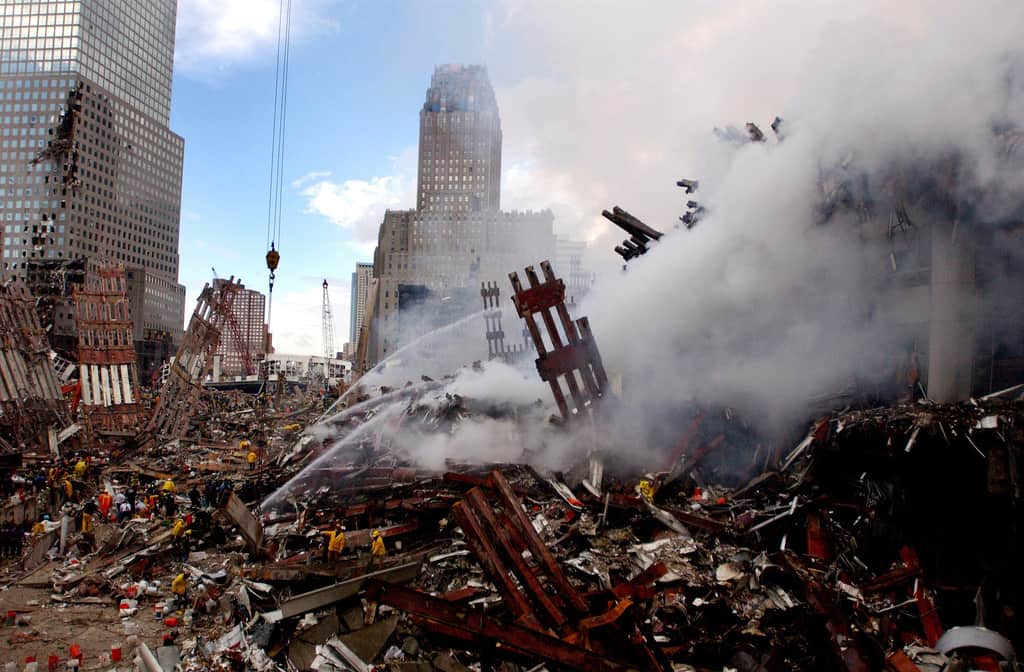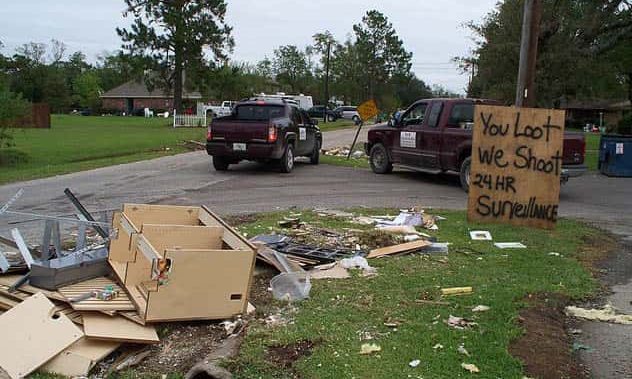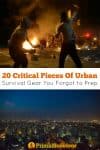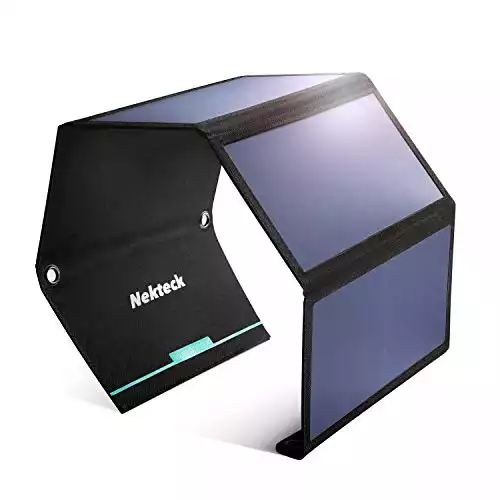In survival and prepper communities, there is a lot of talk about what gear you need to “bug out” in the wild. But the truth is that, in many disaster situations, you are probably better staying put, aka “bugging in” or “hunkering down.”
For these situations, you will need to have urban survival gear.
The items on this urban survival gear are divided into categories based on what they are used for, and we’ve added some things at the end that you may have forgotten!
1. Everyday Carry Urban Survival Gear
Everyday Carry (EDC) refers to all the small items you can easily take with you every day and serve multiple uses.
There are all sorts of cool EDC gear out there that you could buy.
For example, I’ve got a few cool EDC wallet-sized cards that can be taken out in an emergency. I wear a survival belt made from paracord with a blade and firestarter in the buckle.
You don’t need fancy EDC gear, though. You can easily make your own kits. Here is how to make an urban survival EDC kit that can fit into an Altoids tin.
You may need to tweak this list based on your needs, but here is a good starting point.
Everyday Carry Gear Checklist
*Keep this gear on you at all times!
- Multi-tool
- Knife – We picked the best budget knives here.
- Flashlight
- Paracord rope
- Firestarter
- Lock pick
- Water purification tablets
- Paper and writing tool
- Safety pins
- Mini first aid kit
- Emergency histle
- Cash in small bills
2. Hazard Protection Urban Survival Gear
The terrorist attacks of September 11th are one of the worst examples of urban disaster the USA has experienced.
It is also an example of how unprepared we are for the environmental hazards which occur during an urban disaster.

When the Twin Towers were struck, it caused a huge dust storm of construction materials to be released into the air.
There was asbestos, lead, mercury, crystalline silica, cadmium, and polycyclic aromatic hydrocarbons, to name just a few.
Over a decade later, the disaster is still taking its toll. Since 2015, more than 2,500 WTC rescue workers and first responders have developed cancer.
It isn’t just asbestos you need to worry about.
- Disasters can cause sewage overflows and hygiene risks.
- Weather-related disasters can cause outbreaks of vector-borne diseases.
- Crowded conditions lead to the outbreak of communicable diseases like respiratory infections.
- Uncleaned wounds can lead to infection and sepsis.
To protect yourself from these environmental hazards, you will need face masks, first aid items for cleaning and treating wounds, a method of purifying water, and heavy-duty gloves and boots to protect you from injury.
Hazard Protection Gear Checklist
*Keep these items at your survival location.
- Work gloves
- Water purification system
- Disinfectants
- First aid kit
- Anti-diarrheal medicines
- Antibiotics
- Potassium iodide thyroid blocker
- Respirator mask
- Gas mask
3. Tools for Looting and Scavenging
We know that one of the things that typically happens within 24 hours of a disaster is looting. Usually, mobs of young men will break down the doors of homes, businesses, and government buildings to grab anything they deem valuable.
Do not join in the looting after a disaster!
Hopefully, you’ve prepared and have enough supplies to get you through the first 30 days. Ride out this time as peacefully as possible. If you’ve secured the perimeter of your home, then you’ll be safe from invaders.
The mobs will still likely be going for the easy targets at that point.
From what we’ve seen in past disasters, looting is always worst in the first week to a month. After that, all the obvious supplies have been picked clean, and only a few stragglers remain wandering through.
Wait until this moment to go out and start looting for supplies. All the TVs and expensive stereo equipment will have been carried off (which will be useless in a disaster!), but you will still be able to find many useful items – like old cans for making a rocket stove and paper which can be turned into fuel.
To loot efficiently, you will need these supplies. These items might be hard to find in the city after an urban disaster, even with good scavenging skills. Make sure you stockpile them at your home base!
Looting Gear Checklist
- Crowbar
- Large, sturdy backpack or bag
- Ax
- Tactical flashlight
- Heavy-duty gloves
4. The Get Home Bag
The Get Home Bag (GHB) is the “Hunker Down” version of a Bug Out Bag. The contents of this bag are designed to help you make your way home after a disaster.
Everyone has different needs with their GHB. The checklist is just for reference. You’ll have to tweak it to suit your needs!
Get Home Bag Checklist
*Keep a GHB in your vehicle, at work, and school.
- Respirator mask
- Work gloves
- Boots
- Mini first aid kit
- Multi-tool
- Water + water purification tablets
- Knife
- Flashlight
- Poncho
- Waterproof matches, lighter
- Emergency whistle
- Emergency radio
- MRE
- Cash
- Copies of vital documents (read which documents you need for disaster situations)
Other Useful Items You May Have Forgotten
1. Crowbar
No matter how much you prepare, you might have to scavenge when SHTF. A crowbar (Amazon link) makes it possible to get into locked and boarded-up abandoned buildings.
I am not encouraging looting – just saying that you should be prepared for anything!
2. Bolt Cutters
Bolt cutters (Amazon link) are essential for scavenging, but also in case you need access to chained-up places.
If you need to cut through chain roadblocks, I’d make sure to have a pair of bolt cutters in your vehicle when evacuating.
They would also be useful for cutting:
- Security fences
- Power cables
- Alarm cables
- Handcuff chains
3. Plywood and Plastic Sheeting
Whether it is a hurricane, tornado, mob riots, or another SHTF disaster, you can expect a lot of broken windows and doors.
You must have a way to board these up to keep intruders and the elements out.
A good rule of thumb is to get enough plywood and plastic sheeting for each window and door in your home.
If you are unsure how to board up your home for emergency preparedness, there is a good guide here. Or watch the video below.
4. Activated Charcoal
Many preppers have stoves for boiling water to treat it and possibly also a survival water filter. However, boiling and filtering will NOT remove chemical contaminants!
You will need activated charcoal (Amazon link) for this.
5. An Emergency Toilet
This should be one of the FIRST pieces of urban survival gear you get. Yet, many preppers don’t want to think about the gross reality of having to crap into a bucket.
But if you don’t get this gear now, it will give a new meaning to SHTF! Learn how to make an emergency 2-bucket toilet here.
6. Fire Extinguisher
This should be self-explanatory.
Check the expiration dates on your current fire extinguishers (Amazon link) to make sure they are still reliable.
7. Emergency Face Mask
September 11th taught us the importance of having a survival mask. Unfortunately, many people are still suffering and dying due to the terrorist attack because of all the toxic debris which was released into the air and caused diseases years after the fact.
I’d recommend getting an N95 face mask. (Amazon link)
8. Solar Charger
Flashlights, rechargeable batteries, emergency radios, and phones are all important survival gear – but are useless if you can’t power them.
There are many emergency power options, such as generators and huge solar panels.
However, a small portable solar charger will suffice for most emergency needs. See here for our recommendations for the best portable solar charger.
9. Heavy-Duty Gloves
How do you plan on cleaning up all that broken glass and debris in your home without work gloves?
How about scavenging for supplies with your bare hands?
Better get several pairs of heavy-duty gloves to be prepared for urban survival!
Read more about the best survival gloves.
10. Axe
My Bosnian friends have told me their survival stories. One thing that stood out is how during the Siege of Sarajevo, they chopped down all of the trees in the parks for firewood.
They also would chop up any loose wood they could scavenge. A survival axe is also great if your crowbar won’t get you into a boarded-up place!
11. Self-Defense Weapon

I know many people are all about firearms for urban survival, but there are plenty of gun alternatives that might make a lot more sense for certain situations.
Remember that you should only stock a firearm for self-defense if you plan to use it.
I’d do anything to protect my family in a true SHTF situation. However, past disasters have shown us that rioters and looters can be as young as 9 years old!
I don’t know how I’d live with myself if I had to shoot a 9-year-old.
So, I’ve made sure to stockpile lots of pepper spray with my urban survival gear too!
Further reading:
- Quick and dirty guide to self defense
- Best pepper spray for self defense
- Best baton for self defense
- Best keychain for self defense
- Best knife for self defense
- Best canes for self defense
- Best umbrellas for self defense
- Best non-lethal weapons
12. Survival Books and Printouts
Most of us have gotten spoiled by having constant internet access. We have all the info and advice for survival at the tips of our fingers… Until the power goes out!
Make sure to have books or printouts of vital survival info, such as:
- How to find, store and treat water in an emergency
- How to make a tarp shelter
- Survival first aid
- Edible plants in your area
- Instructions for using specific survival gear
13. Condoms
With the lights out and nothing to do, sex is one way to relieve the tension… But this is NOT a time you want to get pregnant!
Make sure to have lots of condoms in with your survival gear. You can also use them for bartering.
14. Backup Glasses
Keep an extra pair in your Bug Out Bag. If you can’t afford a third backup, take the BOB pair out if you need them while hunkering down.
15. Shut-Off Wrenches
You must shut off the gas during earthquakes, where gas leaks might occur.
A shut-off wrench is used for this. You’ll also want shut-off wrenches for your plumbing too.
This wrench works for both gas and water – check on Amazon
16. Tools
In addition to shut-off wrenches, you’ll need various tools to help you get through the urban disaster. For example, tin snips (Amazon link) are great for making an emergency stove out of a tin can. Hammer and nails are needed for boarding up windows.
Read: How to make DIY window covers
Here are some of the basic tools you need for emergency preparedness:
- Hammer
- Screwdrivers
- Tin snips
- Saw
- Drill
- Rope
- Shovel – Check out our survival shovel reviews
17. Emergency Raft and Paddles
If you live in a flood or hurricane zone, it is worth buying an emergency raft and paddles. (Amazon link)
Even if the water isn’t coming to your home’s second floor, it is better to use the raft if you have to leave rather than wading through sewage water.
18. Waterproof Waders
Are your survival supplies in the basement?
Will you ever have to leave your home to dispose of waste?
These are two reasons you’ll need waterproof waders (Amazon link): you don’t have to go through the filthy water during flooding!
19. A Get Home Bag
In addition to a Bug Out Bag, you need a “Get Home Bag” with all the survival gear necessary to get you home should an emergency happen while you are out.
Learn more about Get Home Bags here.
20. Buckets
In an urban survival disaster, buckets are used for toilets, collecting debris and trash, storing food, seats, keeping supplies dry… You can never have too many buckets! (Amazon link)
Just make sure to get the waterproof lids, and a bucket opener (Amazon link) is great to have too.
What else would you add to the list of forgotten urban survival gear?










Nowhere was there a mention of a knife. I am talking of a knife or cleaning small game, fish, etc.
Large garbage bags also double as poncho’s and hazmat suits. You can also use them as gloves. As a poncho or wrap they’ll keep you warm, though if you get sweaty you are wet and thats a problem… They also do double duty for carrying water, and other small items like items you forage, or other supplies.
Yeah very versatile although they would have offer extremely limited protection in a Hazmat scenario.
I stocked drum liners after I accidentally bought a box. The They are almost indestructible, (not really) big and thick.
A bike. Increase your foraging/scavenging range, travel more quickly, and haul gear more efficiently. A bike can be loaded up past the rideability point and still walked home pretty easily. The Viet Cong used bikes to haul supplies along the Ho Chi Minh trail, often carrying over 350lbs per bike. Obviously doesn’t have to be a nice bike, just sturdy. Steel is preferable to Aluminium despite the weight, since it’s easier and cheaper to modify and repair with standard instead of Tig welding gear.
I like Portable trolley. Carrying galons of water or firewood from park to your home with hand is wasting a lot of energy
A sturdy cart is good thing to have. There are a couple of good canoe carts that you can easily retrofit with just a couple of U-bolts and a two by four or steel pipe into a good little wheeled travois. Some of the more rugged “off-road” style kids’ strollers are pretty capacious and good for moving gear. Likewise pull behind bike carts for kids. They may not be purpose built or personally approved by Jeff Cooper, but survival is all about Improvising, Adapting and Overcoming.
Backup fuel for heating and cooking should be on your list. Propane fulfills this requirement in most circumstances, as does properly seasoned firewood if you have appropriate means of heating and cooking when the grid goes down.
The area where I lived some years ago got hit by an Alberta Clipper and power was down for several days. An abundant supply of firewood kept the situation from developing into a survival experience. A friend ended up burning his kitchen and dining room chairs to keep from freezing.
Great point. Thanks for the input Ben
A high power by gun ammo is cheap and can kill small animals quietlt
I agree 100%. Air rifles are well suited for the small game you would be hunting in an urban environment.